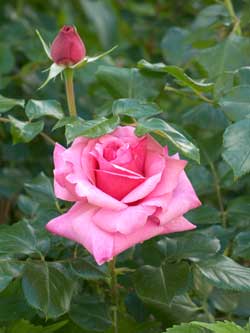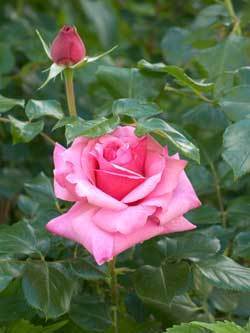
All plants have their specific needs and roses can be especially tricky. There are many things to consider, including how and when you choose your plants, the make-up of your soil, your planting method, and the manner in which you care for them.
In selecting roses there are a few practices to follow that will increase your chances for success. Although bare-root roses are cheaper than potted ones, potted roses have a better survival rate and are easier to plant. Also, older rose varieties and roses that have maintained their original rootstock tend to be hardiest. Roses should be planted in late spring-early summer in order to give the plant time to develop a strong root system before the winter begins.
You need to plant your roses in good soil-rich earth. Too much clay, sand, or rock will hinder the development of your plant. It is especially important to establish and maintain the correct pH level in your soil. Buy an accurate test kit (inexpensive kits are inaccurate) to measure whether your soil is acidic, neutral or alkaline.
The scale of measurement for pH is from 0 (extremely acidic) to 14 (extremely alkaline) with 7 being the neutral measurement. The perfect pH for roses is 6.5, although the plants will do well with a soil pH between 5.5 and 7.
Your soil's pH level, which should be measured and adjusted in the early spring before planting, can be changed by using organic materials such as humus, which will increase the soil's water and nutrient holding capacity, the soil's reserve of slow release nutrients, and the soil's resistance to pH change.
Roses need room; be sure to check on how much your variety will require. Generally, miniatures should be planted a foot apart, hybrid teas, grandifloras, and floribundas 18 to 30 inches apart, and climbers from 8 to 12 feet apart.
 Roses add beauty and grace to any garden. |
The hole for your rose bush should be 2 1/2 times the size of the root-ball. Be sure to put compost into the bottom of the hole and to mix compost with the soil you'll return with the plant. When placing the rose bulb in the hole carefully pack the soil and compost mix under and around the root-ball. To insure proper growth the soil on top of the root-ball should be level with the ground.
Proper care of your roses will give them the best chance for survival. The best time to water your roses is early morning or late afternoon. A good, deep root soaking of about four to five gallons of water once a week is usually best. If you're in an extremely dry region then watering in this manner every three to four days is recommended.
Mulching, adding plant material such as dead leaves and grass to the topsoil around your roses, will increase water retention, enrich the soil, and lead to humus creation. This organic practice will keep your roses healthy and strong.
Roses add beauty and grace to any garden. Whether you plant one rose bush or many varieties, you'll want to follow the simple but important steps outlined above. They'll help insure that you'll have beautiful, flowering plants for years to come.

About The Author: Ellen Brown is our Green Living and Gardening Expert. Ellen Brown is an environmental writer and photographer and the owner of Sustainable Media, an environmental media company that specializes in helping businesses and organizations promote eco-friendly products and services.
Add your voice! Click below to comment. ThriftyFun is powered by your wisdom!
The so called wild roses you talk about is nothing more than the evaisive multi-flora rose. It is a land owners worst nightmare. I believe it was in the beginning used for a barrier during one of the wars (WW1 or WW2).
Add your voice! Click below to comment. ThriftyFun is powered by your wisdom!